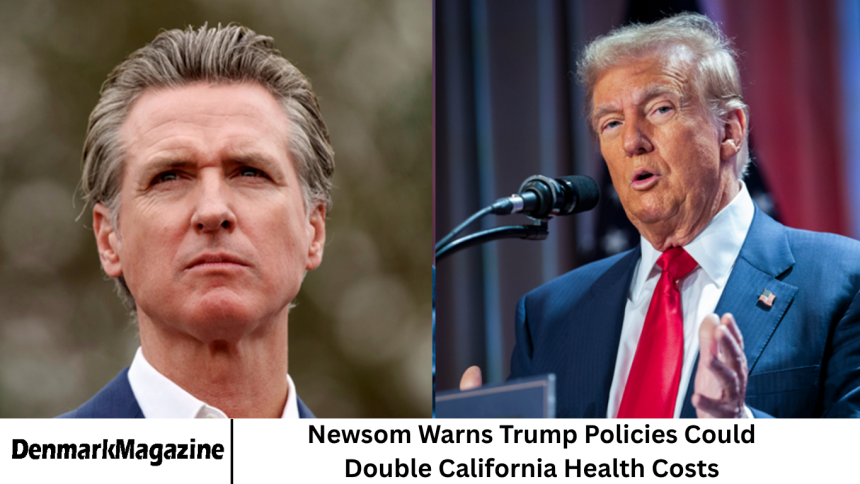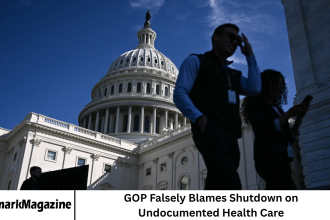California Governor Gavin Newsom has issued a strong warning that health care costs across the state could nearly double within the next three months if former President Donald Trump’s proposed federal policy reversals take effect. The statement, made during a press conference in Sacramento, has ignited a heated national debate.
- Background: The Ongoing Battle Over Health Care Policy
- What Newsom Warned About
- The Specific Policies at Risk
- ACA Subsidies and Tax Credits
- Medicaid Expansion Funding
- Protections for Preexisting Conditions
- Short-Term Health Plans
- Federal Support for State Exchanges
- How Much Could Costs Actually Rise?
- The Political Dimension: Newsom vs. Trump
- Impact on Californians: Who Would Be Hit Hardest?
- California’s Potential Response Plan
- Public Reaction and Political Fallout
- The Broader National Context
- Looking Ahead: The Stakes for 2025 and Beyond
- Frequently Asked Question
- Conclusion
The governor called the potential rise in costs a “direct consequence of Trump-era dismantling of health protections,” warning that the rollback of subsidies, insurance mandates, and coverage requirements could financially devastate working families, small business owners, and the uninsured population.
This article explores Newsom’s warning in depth—analyzing the potential causes behind the projected rise, how Trump’s health care policies differ from current state initiatives, and what the broader implications could be for California’s economy and public health system.
More Read: Yurei Ransomware Spreads Through SMB Shares and Removable Drives to Lock Files
Background: The Ongoing Battle Over Health Care Policy
The debate over health care costs in the United States is far from new. Since the passage of the Affordable Care Act (ACA) in 2010 under President Barack Obama, health care policy has become one of the most divisive issues in American politics. Donald Trump, during his presidency from 2017 to 2021, made several attempts to repeal or weaken the ACA.
Calling it a “disaster” and vowing to replace it with a “better, cheaper” alternative. Although full repeal efforts failed, his administration succeeded in eliminating the ACA’s individual mandate penalty, scaling back enrollment outreach, and allowing the expansion of short-term health plans that critics argue offer less coverage.
California, under Governor Newsom and his predecessor Jerry Brown, took a markedly different path. The state not only embraced the ACA but also expanded Medi-Cal (California’s Medicaid program), created the state-run exchange Covered California, and provided additional state-level subsidies to help middle-income residents afford insurance.
These measures made California a national model for progressive health reform—but also highly vulnerable to federal policy shifts.
What Newsom Warned About
In his recent remarks, Newsom accused Trump of “waging an economic war against working families” through health policy proposals that could slash subsidies, reduce Medicaid funding, and increase out-of-pocket costs for millions.
According to Newsom, internal state projections show that if Trump’s proposed federal changes move forward—specifically those targeting ACA tax credits and Medicaid expansion—premiums in California could rise by as much as 80–100% within three months.
“This isn’t speculation—it’s math,” Newsom said. “If Trump’s rollback goes through, insurers will have no choice but to raise rates. Californians could see their premiums double by early next year. Families who now pay $400 a month may soon pay $800 or more.”
He also pointed out that California receives tens of billions of dollars annually in federal health funding, much of it through ACA-related programs. A reduction in that support, he warned, would force the state either to cut coverage or raise taxes to make up the difference.
The Specific Policies at Risk
Newsom’s warning centers on several key elements of federal health care funding that Trump and some congressional Republicans have signaled interest in changing or removing:
ACA Subsidies and Tax Credits
One of the most immediate threats comes from the potential rollback of enhanced ACA subsidies introduced during the Biden administration. These subsidies made coverage more affordable for millions of Americans through the Inflation Reduction Act. If rescinded, Californians could lose significant premium support.
Medicaid Expansion Funding
California’s Medi-Cal expansion added coverage for millions of low-income residents. A federal cut could force the state to either reduce benefits or limit eligibility.
Protections for Preexisting Conditions
Though Trump has claimed support for maintaining preexisting condition protections, his administration backed court efforts that would have effectively dismantled them. Without these protections, premiums for people with chronic illnesses could skyrocket.
Short-Term Health Plans
Trump expanded short-term insurance options that often exclude key benefits like maternity care or prescription drugs. Critics say these plans drive up costs for everyone else by pulling healthy people out of comprehensive coverage pools.
Federal Support for State Exchanges
Covered California relies on federal infrastructure and funding streams. A withdrawal of federal backing could increase operational costs for the state exchange.
How Much Could Costs Actually Rise?
Independent health economists suggest that the impact of reversing ACA provisions could vary widely but agree that costs would rise substantially. A recent analysis from the Kaiser Family Foundation estimated that repealing the expanded ACA subsidies would raise average premiums by nearly 70% nationally.
In high-cost states like California, the increase could be even higher. Additionally, if federal funding for Medi-Cal expansion is cut, state lawmakers would need to find alternative revenue sources to sustain coverage for millions—potentially through higher state taxes or reduced benefits.
California’s health insurance marketplace, Covered California, has been a success story, maintaining stable rates compared to other states. But Newsom warned that this balance could collapse if Trump’s agenda returns. “The progress we’ve made will evaporate overnight,” he said.
The Political Dimension: Newsom vs. Trump
The warning is not only economic—it’s deeply political. Gavin Newsom, a leading Democrat and frequent Trump critic, has consistently positioned California as a counter-model to Trump’s conservative policies.
In 2025, as Trump’s influence resurges within the Republican Party, Newsom has intensified his national rhetoric, portraying California as the frontline in defending progressive achievements. “Trump’s health policies would hurt families, seniors, and children,” Newsom declared. “We’re fighting for the soul of America’s health care system.”
The Trump campaign, in response, dismissed Newsom’s warning as “fearmongering.” A spokesperson stated, “President Trump’s plan will lower costs through competition, not government control. Newsom’s failed policies have already made California one of the most expensive states to live in.”
This back-and-forth underscores a broader ideological clash: Democrats’ emphasis on government-backed health coverage versus Republicans’ market-driven approach.
Impact on Californians: Who Would Be Hit Hardest?
If the feared cost increases materialize, several groups in California would bear the brunt:
- Middle-Income Families – Those who earn too much for Medi-Cal but rely on ACA subsidies could face huge out-of-pocket increases.
- Small Business Owners – Many depend on small-group plans tied to ACA rules; premium hikes could make employee coverage unaffordable.
- Seniors Under 65 – Those not yet eligible for Medicare but with preexisting conditions would see steep premium surges.
- Rural Residents – Areas with limited competition among insurers could see the sharpest price spikes.
- Young Adults – Those who rely on affordable coverage through parents’ plans or state exchanges could lose access.
For many Californians, the threat is not abstract. Losing subsidies could mean losing coverage altogether, forcing families to choose between medical bills and other necessities.
California’s Potential Response Plan
Governor Newsom has vowed that California will not stand idle if federal policy reversals occur. He outlined several possible countermeasures:
- State Subsidy Expansion: Increase state-level financial assistance to offset federal cuts.
- New Health Care Tax Proposals: Levy taxes on large corporations or high-income earners to fund Medi-Cal.
- Public Option Expansion: Accelerate efforts to create a low-cost, state-backed insurance plan.
- Legal Action: Challenge any federal rollback in court, similar to lawsuits California filed during Trump’s first term.
However, experts note that California’s ability to fully replace lost federal funding is limited. Without federal partnership, even a wealthy state like California could face deficits or reduced coverage.
Public Reaction and Political Fallout
Public reaction to Newsom’s warning has been divided along partisan lines. Health care advocacy groups and progressive organizations rallied behind his statement, urging Californians to contact federal lawmakers. “Trump’s policies would take us backward,” said Anthony Wright, executive director of Health Access California.
“Millions could lose affordable coverage, and health inequities would deepen.” Conversely, conservative think tanks argue that Newsom is overstating the threat to distract from California’s own rising costs. “California already has some of the highest premiums in the country due to state overregulation,” noted Sally Pipes of the Pacific Research Institute.
“Blaming Trump ignores the state’s own policy failures.” The issue could play a significant role in upcoming elections, as health care affordability consistently ranks among the top concerns for voters.
The Broader National Context
California’s alarm reflects a national trend. States that expanded Medicaid or established ACA marketplaces are especially vulnerable to federal policy reversals. If Trump’s approach gains traction again, states like New York, Washington, and Illinois could face similar disruptions.
In contrast, states that did not expand Medicaid, primarily in the South, may experience fewer immediate effects but would also miss out on federal benefits that help low-income residents access care.
Analysts suggest that the renewed debate could push Congress to revisit the ACA’s long-term sustainability and the balance between federal and state responsibilities.
Looking Ahead: The Stakes for 2025 and Beyond
The next few months could be pivotal for health care in California. With federal elections looming and national political dynamics shifting, state leaders are racing to safeguard the programs that millions rely on. Newsom has positioned himself as a defender of the ACA and a national voice for health care equity.
Whether his warnings become reality will depend on congressional decisions, court rulings, and the broader direction of U.S. health policy. But one thing is clear: health care affordability remains at the heart of California’s—and America’s—political and economic future.
Frequently Asked Question
What did Governor Newsom warn about?
Governor Gavin Newsom warned that if Donald Trump’s proposed health care rollbacks are implemented, Californians could see their health care premiums nearly double within three months due to the loss of federal subsidies and Medicaid funding.
Why would health care costs rise so quickly?
The increase would stem from reduced federal support for ACA subsidies and Medi-Cal expansion. Without that funding, insurers would raise premiums to cover losses, and the state might have to scale back assistance programs.
Which groups in California would be most affected?
Middle-income families, small business owners, and residents enrolled in Covered California or Medi-Cal would be hardest hit by rising premiums and potential loss of coverage.
How is California planning to respond?
Newsom has proposed expanding state subsidies, introducing new funding sources, and taking legal action against any federal cuts that undermine California’s health programs.
What was Donald Trump’s response?
The Trump campaign dismissed Newsom’s warning as political fearmongering, arguing that Trump’s policies would reduce costs through competition and deregulation.
How much federal health funding does California currently receive?
California receives tens of billions annually in federal health funding, primarily through Medicaid and ACA subsidies. A rollback could severely affect the state budget.
Could health care costs really double in three months?
While exact figures depend on policy implementation, experts agree that a sudden loss of federal funding could trigger rapid and substantial increases—possibly nearing the doubling effect Newsom predicted.
Conclusion
Governor Gavin Newsom’s stark warning about Trump’s policies potentially doubling California’s health care costs has reignited the long-running national debate over the balance between federal and state responsibility in ensuring affordable health care. While critics argue that his projections are exaggerated, the underlying risks are real.
The dismantling of ACA provisions could have far-reaching consequences—not just for California but for millions of Americans who depend on its framework. As the political battle intensifies, the ultimate question remains: will the United States move toward expanding access to health care, or return to a system where affordability depends on luck, employment, and geography?








